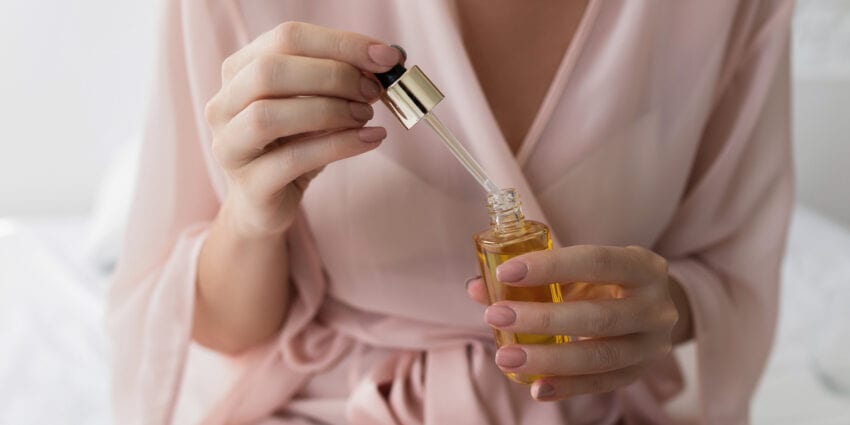I‘ve been using a retinoid product for many years now, and it’s one of the prized possessions of my skin-care routine. If you’re not already using a retinoid vitamin A, know that it’s revered for its anti-aging, glow-inducing, and acne-fighting prowess—and that’s due to its profound ability to speed up your skin cell turnover processes, magically boost collagen production, and so much more holy grail-ishness within skin.
As the average consumer, though, you’ll probably be overwhelmed by the seemingly zillions of retinoid-related terms on the back on ingredient labels that are tough to tell apart. So, to help shed a light on just what exactly these retinol-related ingredients are and what they do, I’ve boiled it down to a few key points.
Retinoids are commonly used in skincare products due to their effectiveness in anti-aging and acne treatment. Retinoids exert this effect by their ability to diffuse through dermal cell membranes, then be converted to retinoic acid, which binds to specific nuclear receptors and modulates expression of the genes involved in cellular proliferation and differentiation. Non-gene actions include ultraviolet (UV) absorption, as well as antimicrobial, antioxidant, and pigment-reducing activities.
Retinol, tazarotene, retinoic acid, retinal, adapalene, pure retinol… If you’ve ever searched for the much-touted skincare ingredient, you’ve probably encountered a number of these similar sounding terms. Let’s start from the beginning. Retinoids are the umbrella term for any vitamin A derivative product. Some are naturally occurring in the body, while others are pharmaceutical formulations. A few are only available via a doctor’s prescription, while others available through physicians, and still others are over-the-counter and just waiting for you to buy them. They vary in function and strength, which is great for consumers, but can make brands focus more on popular marketing buzzwords rather than ideal and elegant formulations. Each one takes one further stage to convert, and each conversion weakens the strength and effect of the product and the results you will see are lesser, hence a 1% retinol is still not as effective as a 0.025% retinoic acid. Although, on the other hand, you’ll also experience fewer unwanted side effects, like redness, peeling, and dry skin from the gentler, weaker products.
Retinoid vitamin A derivatives can be classified in five core categories: retinyl esters, retinol, retinaldehyde, retinoic acid esters, and retinoic acid. Retinoic acid is the most potent because it is the biologically “active form” inside the dermis. All vitamin A derivatives must convert to retinoic acid through a number of conversion steps. In general, the further removed from retinoic acid, the less effective the retinoid is. From there, to help you decipher the retinoid world, let’s go from the most gentle to the most potent.

Retinol Esters
This process starts with the gentlest retinoid molecules known as retinol esters (or, alternatively, retinyl esters). They are the “storage form” of retinoids. Examples are retinyl palmitate, retinyl acetate, and retinyl propionate. Vitamin A esters like retinyl palmitate have a three–step process to become the active retinoic acid (retinyl palmitate🡪retinol🡪retinaldehyde🡪retinoic acid). The drawn-out conversion process of retinyl esters militate against their efficacy.
Retinol
Retinol is the “transport form” of vitamin A. Their conversion to retinoic acid requires two steps, thus they are more effective than retinyl esters. This is the most common form of vitamin A you’ll see in both OTC and medical brands. Arguably the most visible retinoid on the market, retinol is also naturally occurring in the body and is the most well-studied topical option. Retinol is highly unstable in UV light in most formulas, which is why the manner in which your product was formulated and packaged is crucial to ensure its efficacy. The delivery system once the bottle or jar is on your shelf will also determine how long it lasts, meaning if the formula is exposed to light and air, it will lose potency more rapidly than an airtight pump (depending on what kinds of preservatives it contains).
The efficacy of retinol also depends on concentration—higher concentrations result in higher conversion rates to retinoic acid. However, higher concentrations of retinol can sometimes lead to increased irritation, the same problem encountered with, for example, prescription-strength Retin-A. The upside here is that if you experience irritation when using a high-concentration retinol product without known irritating preservatives (parabens or sodium benzoate), you are very likely reaping the benefits of retinoic acid being absorbed into the skin’s cell receptors.
Retinal, AKA Retinaldehyde
Next comes retinal (a.k.a. retinaldehyde). An example is retinyl retinoate. This might be one of the trickiest terms to differentiate in the skin-care market, since at first glance it looks like “retinol” but with a spelling error. But, in fact, retinal is simply a rebranding of retinaldehyde. Both retinol and retinal need to evolve into retinoic acid before they can activate the three retinoic acid receptors. For retinal, it is a simple oxidation conversion to active retinoic acid.
Retinoic Acid Esters
Also a one-step conversion are the retinoic acid esters, glyceryldiretinoate (GDR), retinyl retinoate, and hydroxypinacolone retinoate (HPR). The beauty of these molecules is that they not only convert to retinoic acid, but also directly stimulate the same retinoic acid receptors that retinoic acid itself does, thus making them only slightly less potent than retinoic acid. Studies demonstrate that these support up to eight times the collagen synthesis of retinol and are very well-tolerated. In other words, they are related to retinoic acid, but it’s not a direct descendant- more a first cousin.
Retinoic Acid
In its prescription form, retinoic acid is known as tretinoin (brand name Retin-A). If you aren’t seeing the acne-clearing or skin-renewing results you want from your over-the-counter products, it might be time to ask us about this stronger option. However, tretinoin is more potent than over-the-counter products because it does not need to be converted to be active. As such, you might also experience more dryness, peeling, and irritation as your skin gets accustomed to such a strong active ingredient. Tretinoin activates all three retinoic acid receptors and to the greatest degree, making it generally the most powerful therapeutic agent overall. Each of the three retinoic acid receptors (alpha, beta, gamma) plays a different role in vital skin processes and behaviors, ranging from exfoliation, oil production, cell turnover, pigmentation, and collagen production. This category also includes isotretinoin (Accutane).
Adapalene, Tazarotene, and Bakuchiol
Adapalene is a bit of a horse of a different color. It is a synthetic retinoid derivative thought to only activate the beta and gamma retinoic acid receptors and is therefore focused on key issues like psoriasis, keratosis pilaris, and mild acne. It is more easily tolerated, but for aging, there are limited studies regarding efficacy for photodamage or wrinkling reduction. For acne, it’s better light stability and lessened skin irritation are a few reasons to try this as opposed to retinoic acid—plus, it’s available over the counter, although we’d still recommend chatting with us to discuss how to use it most effectively.
Another synthetic compound, Tazarotene isn’t a true retinoid, but it also only activates the beta and gamma retinoic acid receptors specifically. It has been considered to be one of the most powerful retinoids, but also the most potentially irritating. It is a prescription-only product that is often used to treat acne, fine lines, certain types of dark spots, and psoriasis.Bakuchiol is a plant-based, vegan ingredient that seems to be showing up everywhere right now. Although it isn’t chemically related to retinol, it binds to retinoic acid receptors in the skin and delivers similar results. Bakuchiol is a meroterpene phenol, which doesn’t look like retinol from a chemical structure standpoint, but functions in the skin similarly.
Bakuchiol also has powerful anti-bacterial properties, which are useful in treating acne breakouts, and also helps to regulate your cells’ mitochondria to prevent oxidative stress, which can lead to signs of aging. If you’re in the market for a much gentler product to treat and repair your skin, this might be one of your best options.
How to Choose the Right Product
At this point you might be wondering, why not just use Retin-A? Retin-A (tretinoin/trans-retinoic acid) is exceptionally strong, but adults with both acne and aging issues will want to get the full benefit of retinoic acid if they can tolerate it. Some people experience irritation at first, which generally improves over time. If not, we may decide to try a different prescription.
On the other hand, if you want to avoid side effects like dryness and irritation but still see significant improvements in your skin, retinal or GDR might be the way to go. In head-to-head clinical trials, retinal shows nearly identical clinical effectiveness to retinoic acid in all the areas that matter (wrinkle reduction, turnover rate, oil control) but without any of the unwanted effects. Study clinicians had a hard time even getting people to complete the retinoic acid studies, while 100 percent of retinal subjects completed without irritation.
For most, retinol will be the easiest, and still effective, way to go. Look for a product with the following profile:
- Contains an encapsulated version of retinol (protects against degradation).
- Contains an effective concentration of retinol. Target is 0.25%- 1%. Anything less is not effective. Anything more is too irritating.
- Does not contain retinyl palmitate or other vitamin A ester (too far removed in the conversion chain).
- Does not contain preservatives like parabens, phenoxyethanol or sodium benzoate that may irritate skin.
Or, better yet, come on in and we’ll guide you every step of the way!



